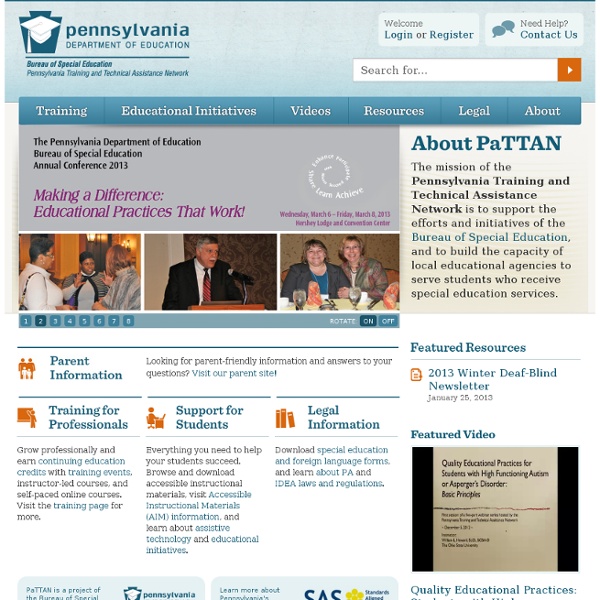



Developing Reading skills There is always a debate about teaching reading at F.E level to students with a learning disability(i.e teach them to use the skills they already have rather than learning using phonics) If you do want to have a go at using phonics and teaching tricky words here are some links to help you: A guide from DFES Letters and Sounds guidance from Department of EducationAn introduction to synthetic phonics from dyslexics.org.uk An over view of how and when to introduce the sounds and words can be found at:
Before Special Ed: How Pre-Referral Works - Identifying a Learning Disability By Colleen Stump, Ph.D. If your child is struggling to learn, take time to find out about how the pre-referral process works at your school. When you become involved in planning with her educational team, your child will benefit. UDL Examples and Resources Disclaimer: The examples and resources highlighted on these pages have been gathered for educational purposes. CAST does not necessarily endorse the products listed, nor does their inclusion here mean that these products are complete expressions of the UDL principles and guidelines. They may illustrate certain principles and not others. Below, you will find teacher-friendly examples and resources that illustrate each of the UDL checkpoints.
Educators Evaluate Learning Benefits of iPad UserID: iCustID: IsLogged: false IsSiteLicense: false Learning Disabilities in Children: Symptoms, Types, and Testing What are learning disabilities? Learning disabilities, or learning disorders, are an umbrella term for a wide variety of learning problems. A learning disability is not a problem with intelligence or motivation. Kids with learning disabilities aren’t lazy or dumb. In fact, most are just as smart as everyone else. Their brains are simply wired differently.
Search lessons by keyword Jeopardy [SMART Notebook lesson] A jeopardy game template to be used for a chapter review, or end of year testing review. It takes a while to g... Some Types of Learning Disabilities Some Types of Learning Disabilities — The First Step is Understanding Some types of learning disabilities can be "treated" through proper testing and training. The key is to identify the specific cognitive weaknesses causing the "disorder" and strengthen those cognitive skills through dynamic, one-on-one training and practice. For the parent, the first step is to understand the types of learning disabilities that may be affecting your child. Some Types of Learning Disabilities — General Processing Issues Some types of learning disabilities are categorized by the cognitive processing problem.
New ‘Dyslexie’ font helps dyslexics read better AFP/ Those in a study of the font say it improves reading accuracy. A graphic designer from the Netherlands, Christian Boer, has developed a new font to aid his dyslexia. The font, called Dyslexie, isn’t the first of its kind, but according to Scientific American in an article published Wednesday, “it has received much fanfare from sufferers.”
ARKive - Discover the world's most endangered species Wildscreen's Arkive project was launched in 2003 and grew to become the world's biggest encyclopaedia of life on Earth. With the help of over 7,000 of the world’s best wildlife filmmakers and photographers, conservationists and scientists, Arkive.org featured multi-media fact-files for more than 16,000 endangered species. Freely accessible to everyone, over half a million people every month, from over 200 countries, used Arkive to learn and discover the wonders of the natural world. Since 2013 Wildscreen was unable to raise sufficient funds from trusts, foundations, corporates and individual donors to support the year-round costs of keeping Arkive online.
30 Ideas for Teaching Children with Attention-Deficit/Hyperactivity Disorder by Leah Davies, M.Ed. By Leah Davies, M.Ed. The following list may assist teachers who work with ADHD students. For an overview of this disorder see, "Attention-Deficit/Hyperactivity Disorder in Children." Math, English programs, games, worksheets for grades K-8 - Dositey.com educational site Enjoy a wide range of lessons, practice exercises, step-by-step tutorials, and printable worksheets... Try today: Grades K-2: Phonics, Adding Same Numbers, Beginning Fractions
UDL Goal Setter: Tools & Activities: Teaching Every Student The key to helping all students achieve is identifying and removing barriers from our teaching methods and curriculum materials. One effective way to do this is to expand your teaching toolbox with digital media and software. To accommodate a broad spectrum of learners, universally designed curricula require a range of options for accessing, using, and engaging with learning materials. The materials themselves, as well as the teaching approaches, need to be sufficiently flexible to support varied pathways towards common learning goals.
Comprehension - The Reading Lady Reading Comprehension A while back I wrote to ask about specific lessons that teachers had written the comprehension strategies in Mosaic of Thought, since I wanted to do some lessons in second grade classrooms. Right after that I got the book Strategies That Work. The two books together have been just what I needed to write the lessons In order to write my lessons I found myself: using lessons right from Strategies That Work, but substituting books (in most cases) that I thought were best for the second grade kids I work with.adding some of the specific language from Mosaic of Thought to the lesson to clarify, for students, how the activity would help them be a better reader.modifying some of the lessons from Strategies That Work for 2nd grade (it is a K-12 book). In Strategies That Work the authors talk about "anchor lessons" and the importance of using the first lessons as a way for students to remember a specific strategy and remember it.